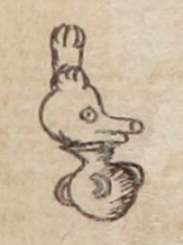Coxcox (Verg7v)
This black-line drawing of the compound glyph for the personal name Coxcox (“Pheasant,” attested here as a man’s name) shows a profile view of the head of a pheasant (cocoxtli) facing right. Below this is a ceramic pot (comitl) with three handles, a round jug, and a flared neck. The ceramic pot is there as a phonetic hint that the name begins with "Co-."
Stephanie Wood
The coxcoxtli is a fairly rare bird, as is the cuixtli (see below). Eagles, egrets, turkeys, hummingbirds, etc., are much more common.
Coxcox was the personal name of a tlatoani of Culhuacan (Colhuacan), as seen in the Codex Boturini. [See: Lori Boornazian Diel, The Tira de Tepechpan (2009), 30.] He is also mentioned as the son of Acolmiztli in the Codex Xolotl. [See: Eduardo de J. Douglas, In the Palace of Nezahualcoyotl (2012), 228.]
Stephanie Wood
juan coxcox
Juan Coxcox
Stephanie Wood
1539
Jeff Haskett-Wood
faisanes, pheasants, ollas, cantaros, jarras

coxcox(tli), a pheasant, https://nahuatl.wired-humanities.org/content/coxcoxtli
La Faisán
Stephanie Wood
Codex Vergara, folio 7v, https://gallica.bnf.fr/ark:/12148/btv1b84528032/f22.item.zoom
The non-commercial reuse of images from the Bibliothèque nationale de France is free as long as the user is in compliance with the legislation in force and provides the citation: “Source gallica.bnf.fr / Bibliothèque nationale de France” or “Source gallica.bnf.fr / BnF.” We would also appreciate a citation to the Visual Lexicon of Aztec Hieroglyphs, https://aztecglyphs.wired-humanities.org/.






